Plasma Assisted Re-Ignition of Aeroengines under High Altitude Conditions
Abstract
:1. Introduction
2. Experimental Setup and Electrical Characterization
3. Numerical Procedure
4. Results and Discussions
4.1. Electrial Characterization
4.2. Flow Visualization
4.3. Production of Active Particles
4.4. Ignition Characteristics at Low Pressure and Temperature Conditions
5. Conclusions
Author Contributions
Funding
Conflicts of Interest
References
- Starikovskiy, A.; Aleksandrov, N. Plasma-Assisted Ignition and Combustion. Prog. Ener. Comb. Sci. 2013, 39, 61–110. [Google Scholar] [CrossRef] [Green Version]
- Ju, Y.; Lefkowitz, J.K.; Reuter, C.B.; Won, S.H.; Yang, X.; Yang, S.; Sun, W.; Jiang, Z.; Chen, Q. Plasma Assisted Low Temperature Combustion. Plasma Chem. Plasma Process. 2016, 36, 85–105. [Google Scholar] [CrossRef]
- Starikovskiy, S.M. Topical review: Plasma-assisted ignition and combustion. J. Phys. D Appl. Phys. 2006, 39, 265–299. [Google Scholar] [CrossRef]
- Ruma, M.; Ahasan, H.; Ranipet, H.B. A Survey of Non-thermal plasma and their generation methods. Int. J. Renew. Energy Environ. Eng. 2016, 4, 6–12. [Google Scholar]
- De Giorgi, M.G.; Pescini, E.; Marra, F.; Ficarella, A. Plasma actuator scaling down to improve its energy conversion efficiency for active flow control in modern turbojet engines compressors. Appl. Therm. Eng. 2016, 106, 334–350. [Google Scholar] [CrossRef]
- Francioso, L.; De Pascali, C.; Pescini, E.; De Giorgi, M.G.; Siciliano, P. Modelling, fabrication and plasma actuator coupling of flexible pressure sensors for flow separation detection and control in aeronautical applications. J. Phys. D Appl. Phys. 2016, 49, 235201. [Google Scholar] [CrossRef]
- Ju, Y.; Sun, W. Plasma Assisted Combustion: Dynamics and Chemistry. Prog. Energy Combust. Sci. 2015, 48, 21–83. [Google Scholar] [CrossRef]
- Tholin, F.; Lacoste, D.A.; Bourdon, A. Influence of Fast-Heating Processes and O Atom Production by a Nanosecond Spark Discharge on the Ignition of a Lean H2-Air Premixed Flame. Combust. Flame 2014, 161, 1235–1246. [Google Scholar] [CrossRef]
- Aleksandrov, N.L.; Kindysheva, S.V.; Kukaev, E.N.; Starikovsjaya, S.M.; Starikovskii, A.Y. Simulation of the Ignition of a Methane-Air Mixture by a High-Voltage Nanosecond Discharge. Plasma Phys. Rep. 2009, 35, 867–882. [Google Scholar] [CrossRef]
- Benard, N.; Braud, P.; Pons, J.; Touchard, G.; Moreau, E. Quasi-steady and unsteady actuation by surface non-thermal plasma discharge for control of a turbulent round air jet. J. Turbul. 2007, 8, N49. [Google Scholar] [CrossRef]
- Bernard, N.; Bonnet, P.J.; Touchard, G.; Moreau, E. Flow control by dielectric barrier discharge actuators: Jet mixing enhancement. AIAA J. 2008, 46, 2293–2305. [Google Scholar] [CrossRef]
- Xu, C.; Li, L. Electric effects on the pre-mixing process in DBD assisted combustions. Appl. Mech. Mater. 2015, 722, 235–238. [Google Scholar] [CrossRef]
- Kosarev, I.N.; Aleksandrov, N.L.; Kindysheva, S.V.; Starikovskaia, S.M.; Starikovskii, A.Y. Kinetics of Ignition of Saturated Hydrocarbons by Nonequilibrium Plasma: CH4-Containing Mixtures. Combust. Flame 2008, 154, 569–586. [Google Scholar] [CrossRef]
- Starik, A.M.; Kozlov, V.E.; Titova, N.S. On the influence of singlet oxygen molecules on the speed of flame propagation in methane–air mixture. Combust. Flame 2010, 157, 313–327. [Google Scholar] [CrossRef]
- Uddi, M.; Jiang, N.; Mintusov, E.; Adamovich, I.V.; Lempert, W.R. Atomic oxy- gen measurements in air and air / fuel nanosecond pulse discharges by two photon laser induced fluorescence. Proc. Combust. Inst. 2009, 32, 929–936. [Google Scholar] [CrossRef]
- Pancheshnyi, S.; Eismann, B.; Hagelaar, G.J.M.; Pitchford, L.C. ZDPlaskin Zero-Dimensional Plasma Kinetic Solver 2008. Available online: http://www.zdplaskin.laplace.univ-tlse.fr/ (accessed on 8 September 2021).
- Lutz, A.E.; Kee, R.J.; Miller, J.A. SENKIN: A FOR- TRAN Program for Predicting Homogeneous Gas Phase Chemical Kinetics with Sensitivity Analysis; Report No. SAND87-8248; Sandia National Laboratories: Livermore, CA, USA, 1988. [Google Scholar]
- Capitelli, M.; Ferreira, C.M.; Gordiets, B.F.; Osipov, A.I. Plasma Kinetics in Atmospheric Gases; Springer: Berlin/Heidelberg, Germany, 2000. [Google Scholar]
- Flitti, A.; Pancheshnyi, S. Gas heating in fast pulsed discharges in N2–O2 mixtures. Eur. Phys. J. Appl. Phys. 2009, 45, 21001. [Google Scholar] [CrossRef] [Green Version]
- Mao, X.; Rousso, A.; Chen, Q.; Ju, Y. Numerical modeling of ignition enhancement of CH4/O2/He mixtures using a hybrid repetitive nanosecond and DC discharge. Proc. Combust. Inst. 2019, 37, 5545–5552. [Google Scholar] [CrossRef]
- Mao, X.; Chen, Q.; Guo, C. Methane pyrolysis with N2/Ar/He diluents in a repetitively-pulsed nanosecond discharge: Kinetics development for plasma assisted combustion and fuel reforming. Energy Convers. Manag. 2019, 200, 112018. [Google Scholar] [CrossRef]
- Fontanarosa, D.; Mehdi, G.; De Giorgi, M.G.; Ficarella, A. Assessment of the impact of nanosecond plasma discharge on the combustion of methane air flames. E3S Web Conf. 2020, 197, 10001. [Google Scholar] [CrossRef]
- Mehdi, G.; Bonuso, S.; De Giorgi, M.G. Effects of Nanosecond Repetitively Pulsed Discharges Timing for Aeroengines Ignition at Low Temperature Conditions by Needle-Ring Plasma Actuator. Energies 2021, 14, 5814. [Google Scholar] [CrossRef]
- Mehdi, G.; De Giorgi, M.G.; Fontanarosa, D.; Bonuso, S.; Ficarella, A. Ozone Production With Plasma Discharge: Comparisons Between Activated Air and Activated Fuel/Air Mixture. In Proceedings of the ASME Turbo Expo 2021: Turbomachinery Technical Conference and Exposition, Virtual, 7–11 June 2021; Volume 3B. Combustion, Fuels, and Emissions V03BT04A036. [Google Scholar] [CrossRef]
- Yoon, S.; Ross, J.; Mench, M.; Sharp, K. Gas-phase particle image velocimetry (PIV) for application. J. Power Sources 2006, 160, 1017–1025. [Google Scholar] [CrossRef]
- Cheng, Y.S.; Bechtold, E.; Yu, C.C.; Hung, I.F. Incense smoke: Characterization and dynamics in indoor environments. Aerosol Sci. Technol. 1995, 23, 271–281. [Google Scholar] [CrossRef]
- See, S.W.; Balasubramanian, R.; Joshi, U.M. Physical characteristics of nanoparticles emitted from incense smoke. Sci. Technol. Adv. Mater. 2007, 8, 25–32. [Google Scholar] [CrossRef] [Green Version]
- Hosokawa, M.; Kiyoshi, N.; Naito, M.; Yokoyama, T. Nanoparticle Technology Handbook, 1st ed.; Elsevier: Amsterdam, The Netherlands, 2007; ISBN 9780080558028. [Google Scholar]
- Hinds, W.C.; Zhu, Y. Aerosol Technology: Properties, Behaviour, and Measurement of Airborne Particles; John Willey & Sons, Inc.: Los Angeles, CA, USA, 1998. [Google Scholar]
- Tropea, C.; Yarin, A.L.; Foss, J.F. Springer Handbook of Experimental Fluid Mechanics; Springer: Berlin, Germany, 2007. [Google Scholar]
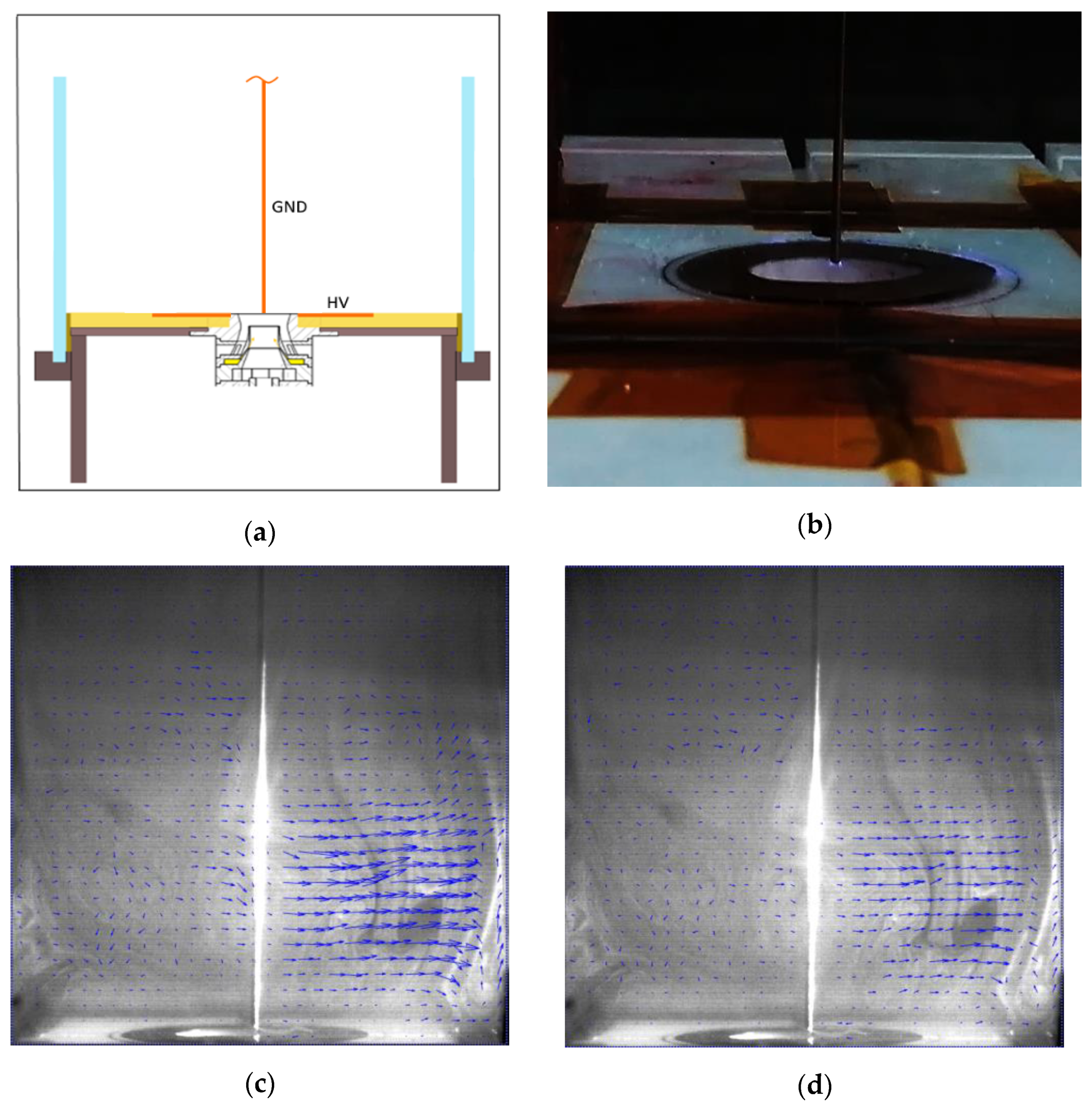

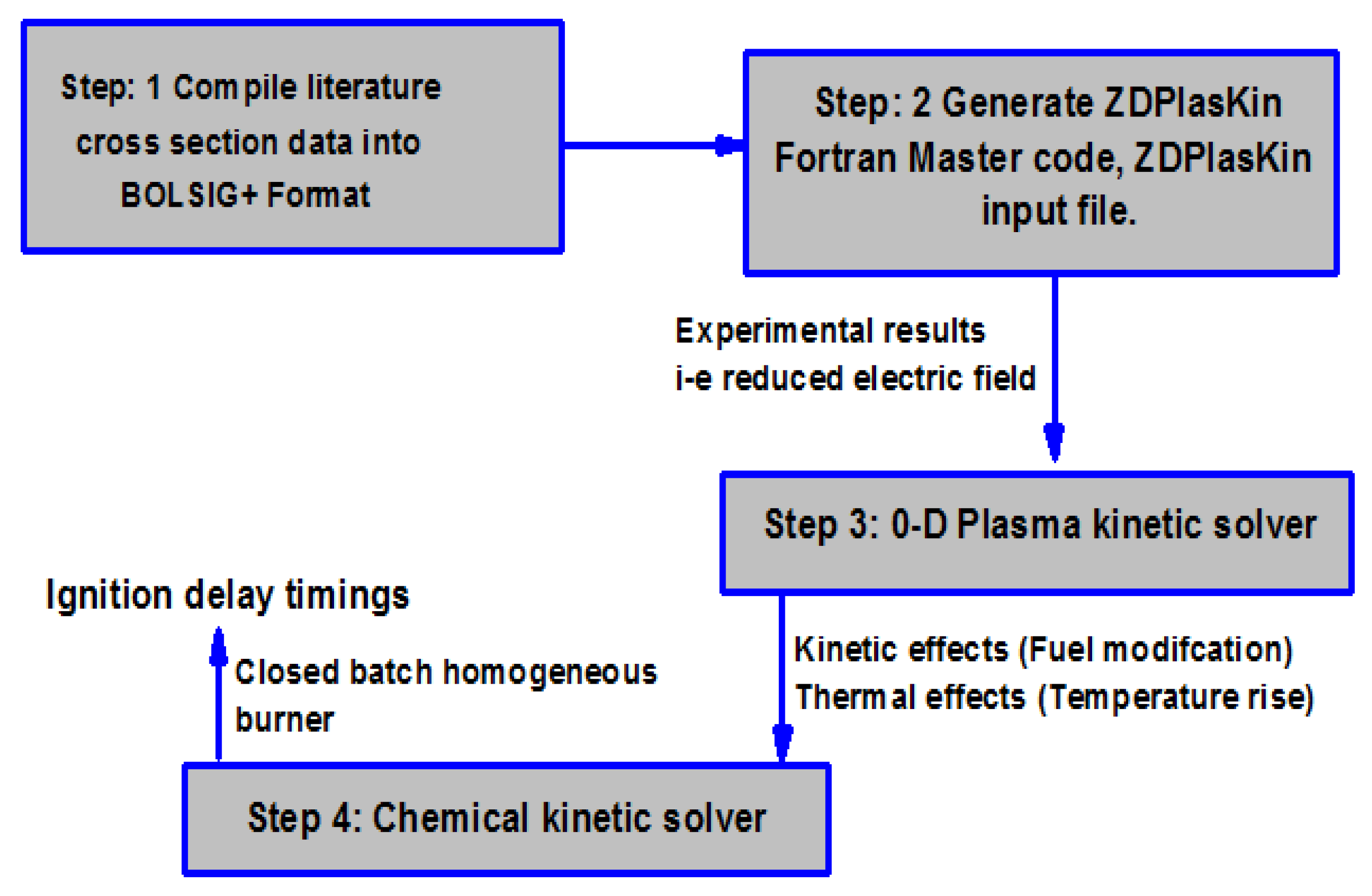
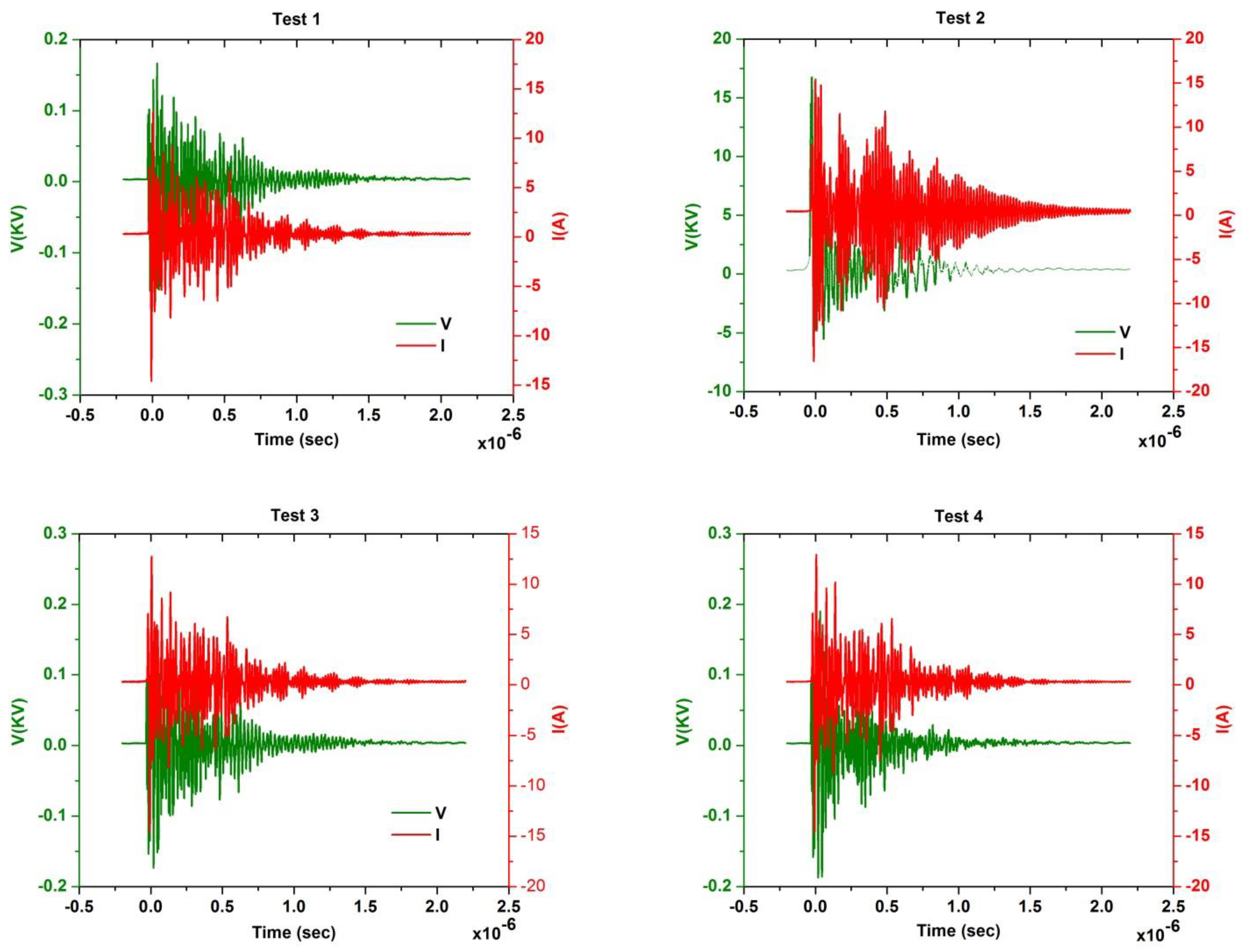
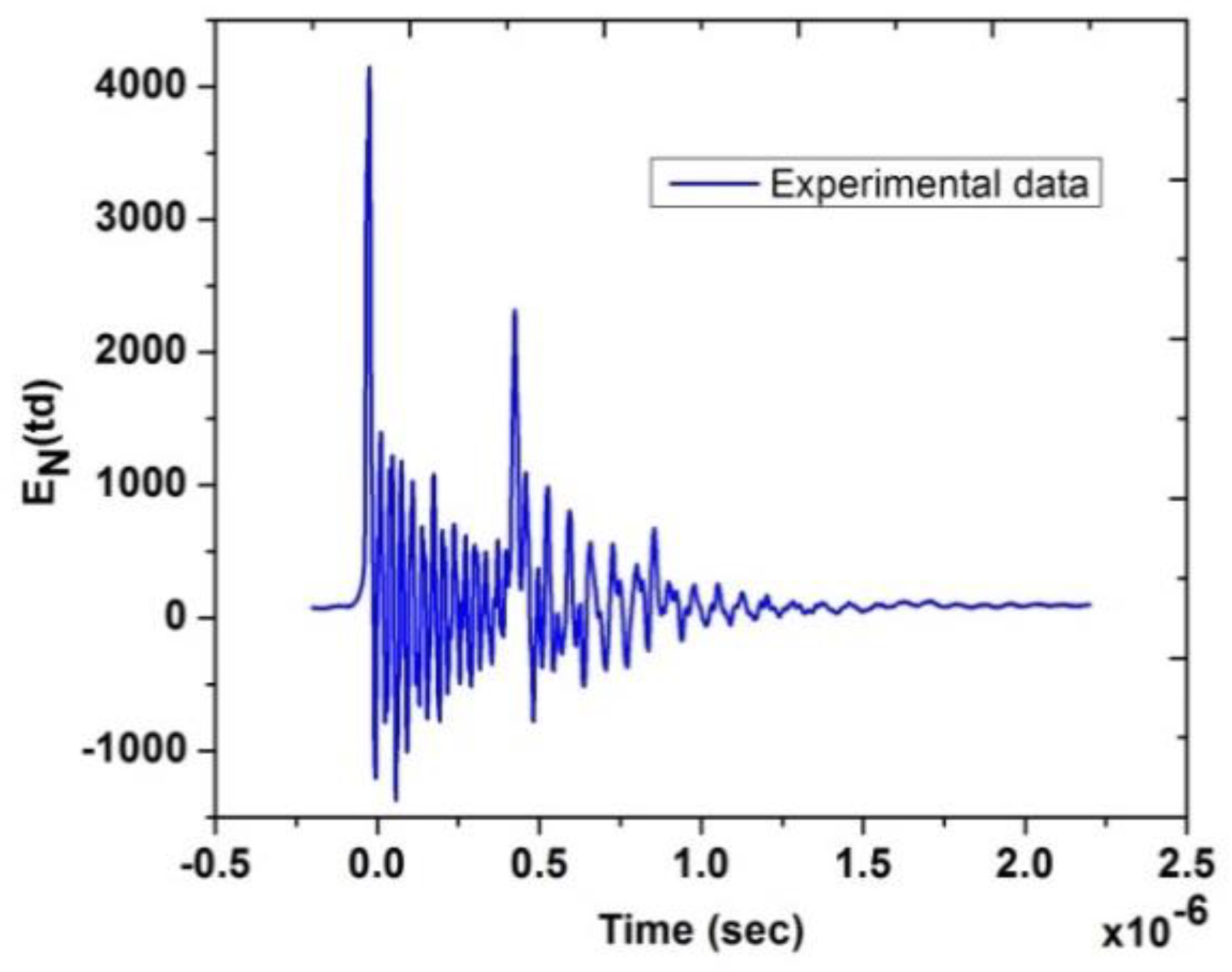
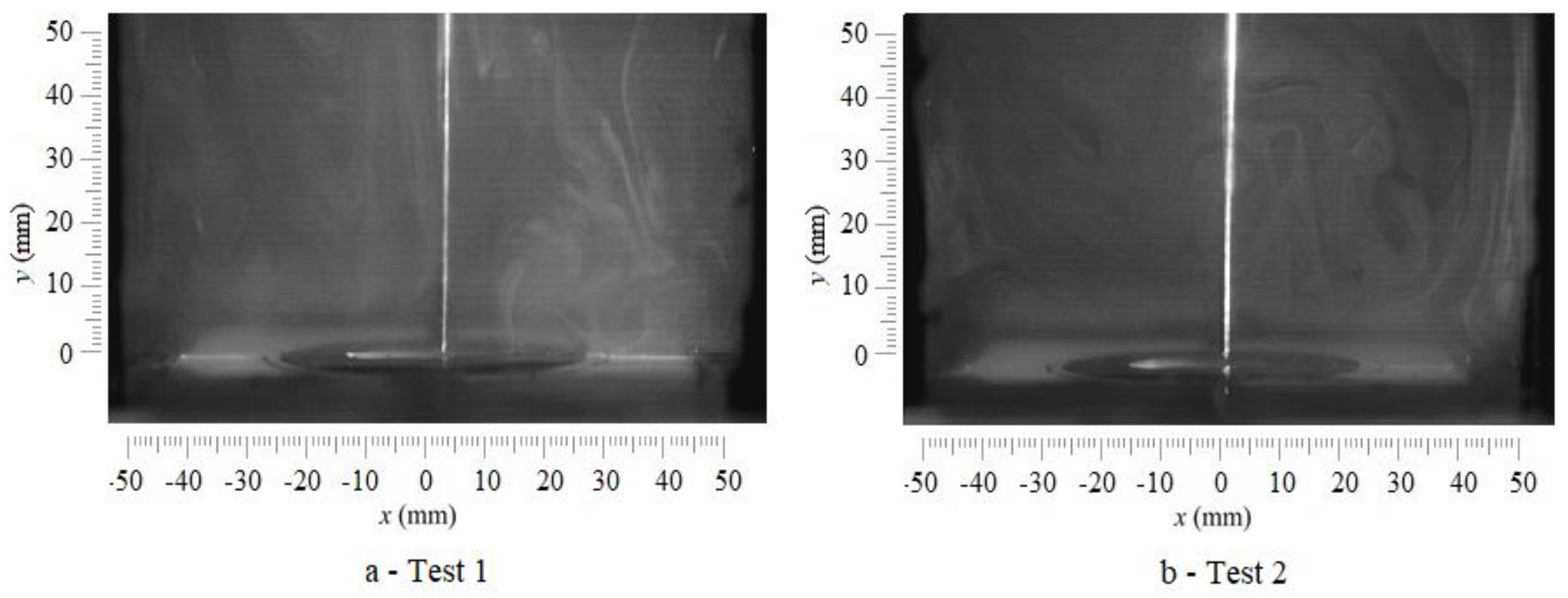



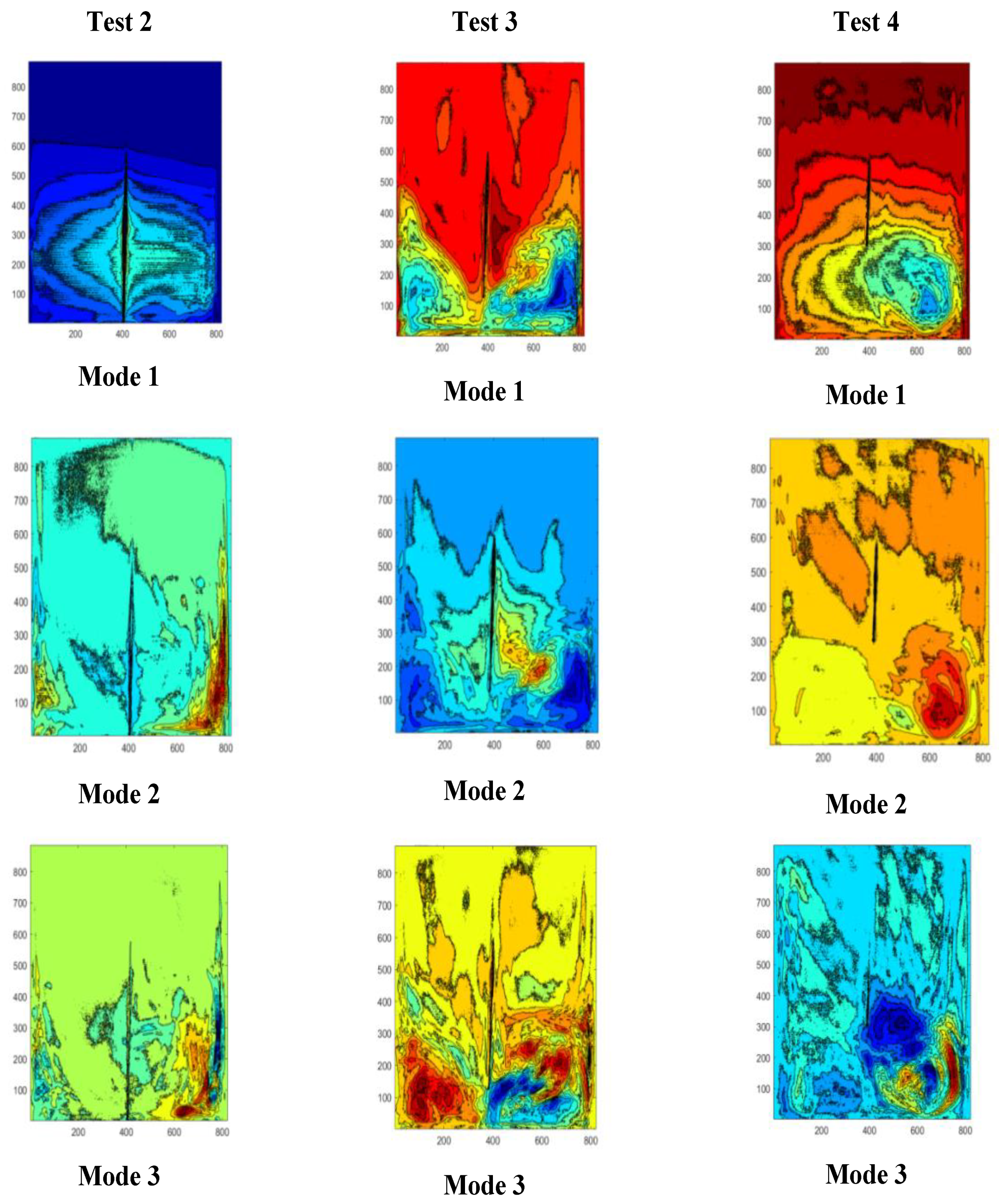

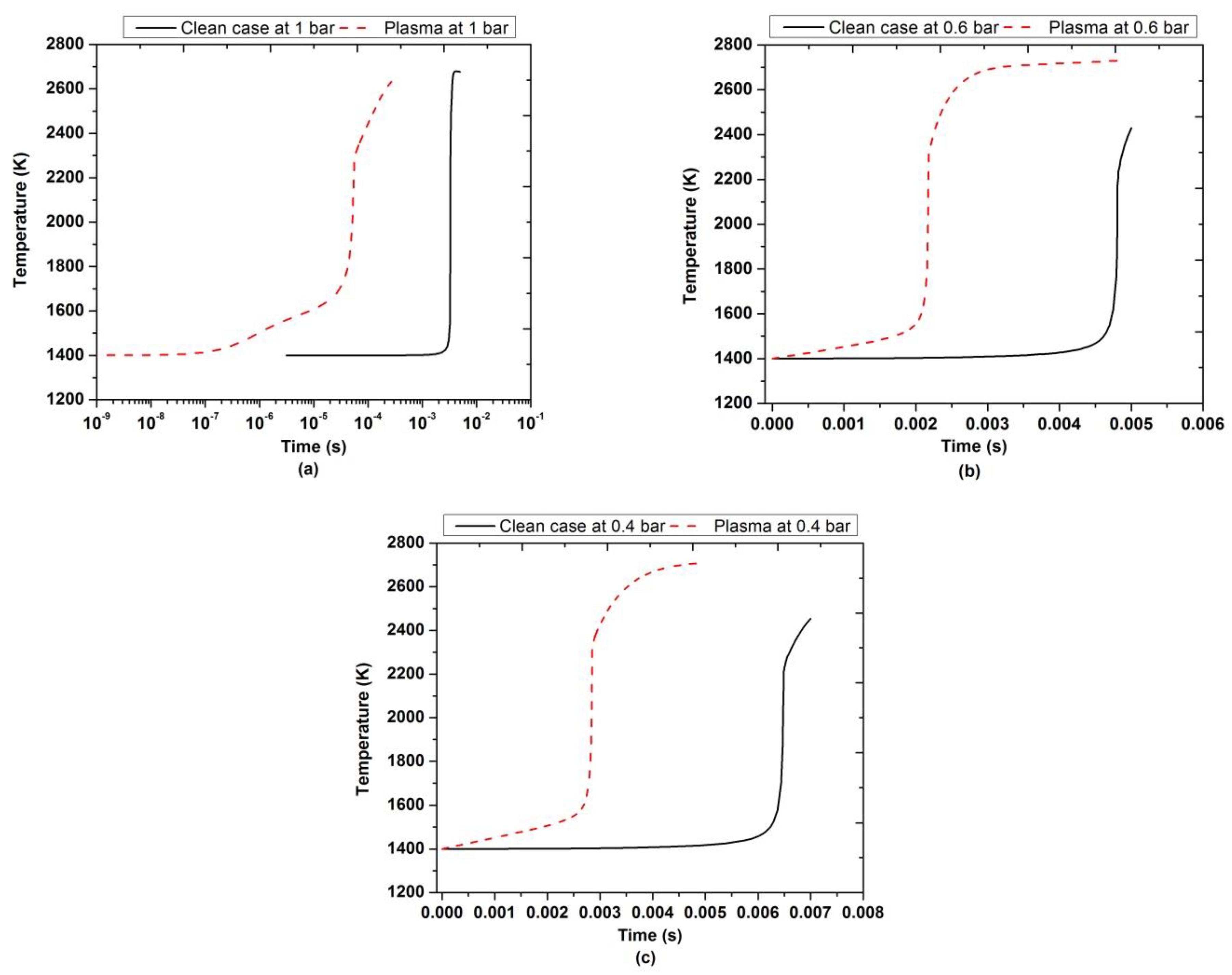
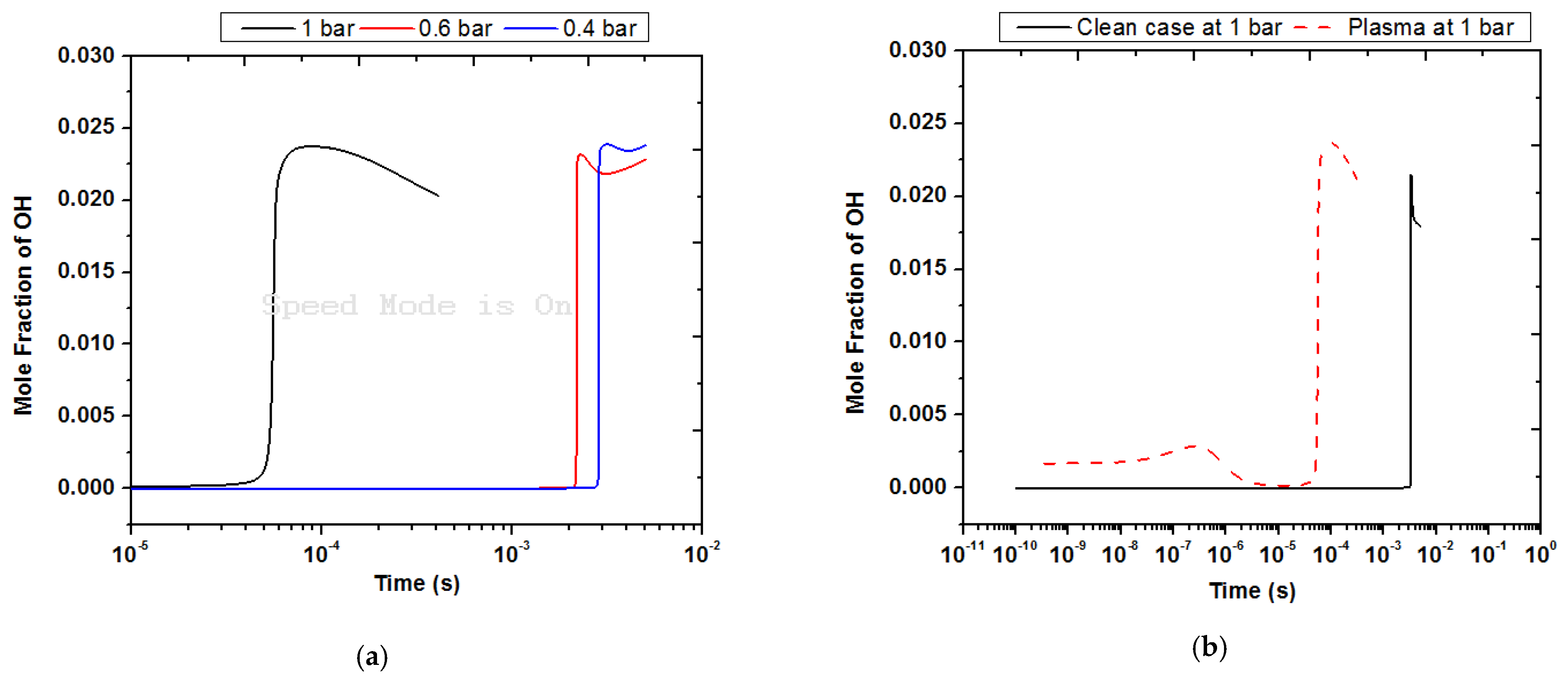


| Test Case No. | Actuator Configuration | Actuation Conditions | Standoff Distance (mm) | |||
|---|---|---|---|---|---|---|
| High-Voltage | Ground | Generator | Amplitude (% Vmax) | Frequency (% Fmax) | ||
| 1. | Disk | Needle | Nanopulsed Generator | 20% | 30% | 00 |
| 2. | 40% | 30% | 00 | |||
| 3. | 40% | 30% | 20 | |||
| 4. | 40% | 30% | 40 | |||
| Test Case No. | Voltage Peak (V) | Repetition Rate (Hz) | Pulse Electrical Power (W) | Mean Electrical Power (W) | Uncertainty Pulse Electrical Power (W) |
|---|---|---|---|---|---|
| 1. | 14,152.01 | 813.6697 | 644.4663 | 1.2581 | 70 |
| 2. | 16,795.8 | 755.287 | 660.782 | 1.1974 | 70 |
| 3. | 166.6829 | 1196.602 | 4.2125 | 0.0121 | 0.4 |
| 4. | 189.9815 | 1059.098 | 6.2117 | 0.0158 | 0.5 |
| Pressure | H | O | OH | CH | CH3 | O3 |
|---|---|---|---|---|---|---|
| 1 bar | 0.02581 | 0.0671 | 0.001818 | 0.000175622 | 0.03046 | 0.05062 |
| 0.6 bar | 0.000558261 | 0.00203 | 0.000944928 | 4.912 × 10−6 | 0.00146 | 0.00151 |
| 0.4 bar | 2.96967 × 10−5 | 0.000108 | 6.22008 × 10−5 | 2.5848 × 10−7 | 8.967 × 10−5 | 6.6069 × 10−5 |
Publisher’s Note: MDPI stays neutral with regard to jurisdictional claims in published maps and institutional affiliations. |
© 2022 by the authors. Licensee MDPI, Basel, Switzerland. This article is an open access article distributed under the terms and conditions of the Creative Commons Attribution (CC BY) license (https://creativecommons.org/licenses/by/4.0/).
Share and Cite
Mehdi, G.; Bonuso, S.; De Giorgi, M.G. Plasma Assisted Re-Ignition of Aeroengines under High Altitude Conditions. Aerospace 2022, 9, 66. https://doi.org/10.3390/aerospace9020066
Mehdi G, Bonuso S, De Giorgi MG. Plasma Assisted Re-Ignition of Aeroengines under High Altitude Conditions. Aerospace. 2022; 9(2):66. https://doi.org/10.3390/aerospace9020066
Chicago/Turabian StyleMehdi, Ghazanfar, Sara Bonuso, and Maria Grazia De Giorgi. 2022. "Plasma Assisted Re-Ignition of Aeroengines under High Altitude Conditions" Aerospace 9, no. 2: 66. https://doi.org/10.3390/aerospace9020066
APA StyleMehdi, G., Bonuso, S., & De Giorgi, M. G. (2022). Plasma Assisted Re-Ignition of Aeroengines under High Altitude Conditions. Aerospace, 9(2), 66. https://doi.org/10.3390/aerospace9020066







